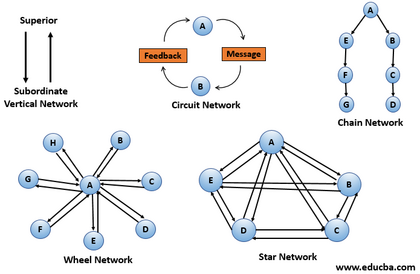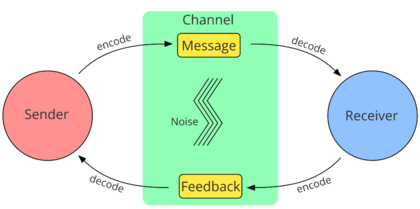Choosing the right communication network for your project
| Line 65: | Line 65: | ||
== Application == | == Application == | ||
| + | |||
| + | === Communication process (see figure 2): === | ||
| + | In the communication process the actors involved are the sender and the receiver. In this figure the green box “Channel” corresponds to what we in this article refers to as the communication media. | ||
| + | For one-way communication: | ||
| + | # The sender must encode the message | ||
| + | # The channel for transmitting the message must be chosen | ||
| + | # The receiver must decode the message from the media | ||
| + | For two-way communication the same procedure occurs, but with additional steps: | ||
| + | # The receiver encodes a feedback message | ||
| + | # The channel for transmitting the feedback message must be chosen | ||
| + | # The original sender must decode the feedback message from the media | ||
| + | |||
| + | In the figure it is also seen that the messages in the channel are disturbed by noise. Noise is all the information that surrounds the specific message, and can be different things such as other people talking in the background, e-mails from other colleagues, body language of the sender etc. | ||
| + | |||
| + | |||
| + | [[File:message.png|420x400 px|thumb|Figure 2. <ref name="Phlsph7 " />]] | ||
| + | |||
| + | '''Importance of the chosen media''' | ||
| + | Depending on the type of media chosen, the information can be more or less “rich”. | ||
| + | {| class="wikitable" | ||
| + | |+ Rich vs. poor information | ||
| + | |- | ||
| + | ! Rich information !! Poor information | ||
| + | |- | ||
| + | | A lot of signals can be transmitted at the same time || Only a few signals can be transmitted at the same time | ||
| + | |- | ||
| + | | Fast feedback || Slow feedback | ||
| + | |- | ||
| + | | High possibility of using natural spoken language || Low possibility of using natural spoken language | ||
| + | |- | ||
| + | | Can be personalized in a high degree || Can only be personalized in a low degree | ||
| + | |} | ||
| + | |||
| + | |||
| + | |||
== Limitations == | == Limitations == | ||
| Line 82: | Line 117: | ||
<ref name="R3"> https://www.educba.com/types-of-communication-network/ </ref> | <ref name="R3"> https://www.educba.com/types-of-communication-network/ </ref> | ||
<ref name="R4"> https://www.oxfordreference.com/display/10.1093/oi/authority.20110803095558631;jsessionid=57E896C5749F968F524AC78D3AC2A9C3 </ref> | <ref name="R4"> https://www.oxfordreference.com/display/10.1093/oi/authority.20110803095558631;jsessionid=57E896C5749F968F524AC78D3AC2A9C3 </ref> | ||
| − | + | <ref name="Phlsph7 "> By Phlsph7 - Own work, CC BY-SA 4.0, https://commons.wikimedia.org/w/index.php?curid=125956073 </ref> | |
[[Category:Information flow]] | [[Category:Information flow]] | ||
Revision as of 14:14, 4 April 2023
Written by Emilie Lewis Laurberg
Abstract
The purpose of this article is to clarify the importance of choosing a suitable communication network for an organization. There exists several different communication network structures and hierarchies. Each and every one of the network types has benefits and disadvantages in which it is crucial to choose the best type of communication network for an organization im terms of avoiding fatal consequences and archieve the communication goals for the specific organization.
Contents |
Big Idea
INTRODUCTION Communication has always existed in organizational structures, since it is crucial for the decision making and for the learning in the organization. Communication is the process where one or more persons or groups send or exchange information.The development of new communication technologies have increased the number of communication methods. This is because there has been an increase of communication medias but also by opening up for using another form of content (e.g. language, richness of info will be investigated later on). When interacting with other people it is common to experience that the language used face-to-face is different than if the same information should be published in a report. This supports the meaning of different medias used when communicating. [1]
Why the communication network is an important factor of project management
- Every project is a temporary organization, in which a communication network will happen automatically
- Emerged communication networks can reflect the hierarchy of the organization and vise vesa, thus it may be relevant to implement a formal communication network in terms of rules and structure
- Why be aware of the type of communication networks that are used?
To make the right decisions, to learn efficiently and to align the work tasks, it is important to coordinate internally. The more coordination that is necessary in an organization, the stronger the communication also has to be to avoid misunderstandings. These misunderstandings can e.g. be regarding crucial information in a project such as the deadline, the work load distribution in terms of who is responsible for what, and even the strategy can be skewed if the communication is not sufficient. The right use of communication can also prevent some amount of conflict associated with the internal organization culture. With more information traveling around the organization, the stronger the culture get, and the better the organization can be resistant to conflicts. The whole basis of the decisions depends on the communication, which means it is important that the necessary information is accessible for the decision maker. [1]
Goal of good communication:
The receiver should understand what the sender wishes the receiver to understand.
To do so the sender needs to put himself into the place of the receiver and take some different aspects into account. First of all the language has to be commonly known between the sender and receiver, to gain a common understanding of the simple meaning of words and sentences. Secondly the communication media has to be something the receiver is comfortable with, to avoid insecurity in understanding the message. Lastly it is important to express the importance of the information given, so the message does not disappears. If the receiver receives too much information, e.g. in a large amount of different e-mails, telephone calls, letters or meetings, an information overload may occur. When information overload occurs, the receiver must either ignore some of the messages on purpose or by accident, since all the information cannot be perceived at once. [1]
10 critical functions [1]:
- Convey information
- Creates basis for planning
- Formulates goals and KPIs
- Development of strategy
- Controls behavior
- Coordinates behavior
- Build up relations
- Develops culture
- Connects organizations in networks
- Present the organization to its surroundings

Examples of different types of networks:
- Cetralized and decentralized network structures
- Centralized can make sure everybody knows the same, but information will always have to pass either one person or one media
- Decentralized makes it possible for employees to go directly to their closest leader in smaller groups. This is like in a centralized network, but with several smaller centers instead of just one. This could e.g. be a network structure with one manager, communicating with 5 sub-managers, each communicating with 5 empoyees. This is a hierarchical type of network. Decentralized communication networks comes in deifferent shapes and styles
- Distributed network structures makes it possible for all actors in the network to communicate directly with one another. Pros: The information from one peripheral actor does not have to go through a "central" actor as in the centralized or decentralized networks to get to another peripheral actor. Cons: If one peripheral actor has given a piece of information to another peripheral actor, the other actors will not neccessarily know. This means if a third actor, no matter the "status" in the network, has to find the exact same piece of information, he or she has to search for it to get it without knowing where it is to be found. This is a flat type of network where hierarchical status does not neccessarily matter.
Centralized communication network structure
A centralized communication network is by Oxford Reference described as "A communication network in which one group member has access to more communication channels than any other and therefore tends to process more information than the peripheral group members" [3]
This article will address the possibilities of:
- Keeping the feeling of project ownership at on different levels in an organization due to formal communication networks
- Choosing between vertical and horizontal communication
- Analyzing the type of emerged network in your organization in terms of e.g. number of connections
Key points
- Optimizing the flow of information in a organization
- Making sure the decisions, scope etc. gets around to the people involved
Application
Communication process (see figure 2):
In the communication process the actors involved are the sender and the receiver. In this figure the green box “Channel” corresponds to what we in this article refers to as the communication media. For one-way communication:
- The sender must encode the message
- The channel for transmitting the message must be chosen
- The receiver must decode the message from the media
For two-way communication the same procedure occurs, but with additional steps:
- The receiver encodes a feedback message
- The channel for transmitting the feedback message must be chosen
- The original sender must decode the feedback message from the media
In the figure it is also seen that the messages in the channel are disturbed by noise. Noise is all the information that surrounds the specific message, and can be different things such as other people talking in the background, e-mails from other colleagues, body language of the sender etc.

Importance of the chosen media Depending on the type of media chosen, the information can be more or less “rich”.
| Rich information | Poor information |
|---|---|
| A lot of signals can be transmitted at the same time | Only a few signals can be transmitted at the same time |
| Fast feedback | Slow feedback |
| High possibility of using natural spoken language | Low possibility of using natural spoken language |
| Can be personalized in a high degree | Can only be personalized in a low degree |
Limitations
Communication network structures [1] Strengths in communication network connections: [5]
References
- ↑ 1.0 1.1 1.2 1.3 1.4 Jacobsen, D.I. & Thorsvik, J. (2014). Hvordan organisationer fungerer, Chapter 8. 3rd edition.
- ↑ https://www.educba.com/types-of-communication-network/
- ↑ https://www.oxfordreference.com/display/10.1093/oi/authority.20110803095558631;jsessionid=57E896C5749F968F524AC78D3AC2A9C3
- ↑ By Phlsph7 - Own work, CC BY-SA 4.0, https://commons.wikimedia.org/w/index.php?curid=125956073
- ↑ Granovetter, M. (1973). The Strength of Weak Ties